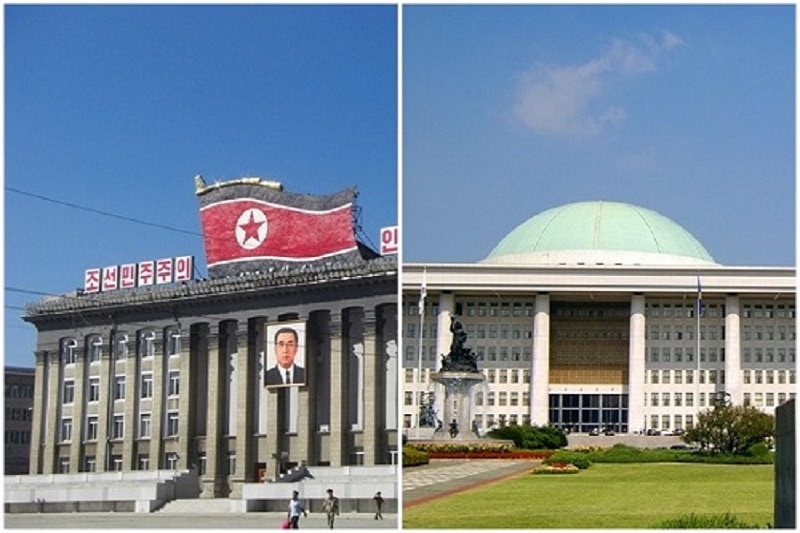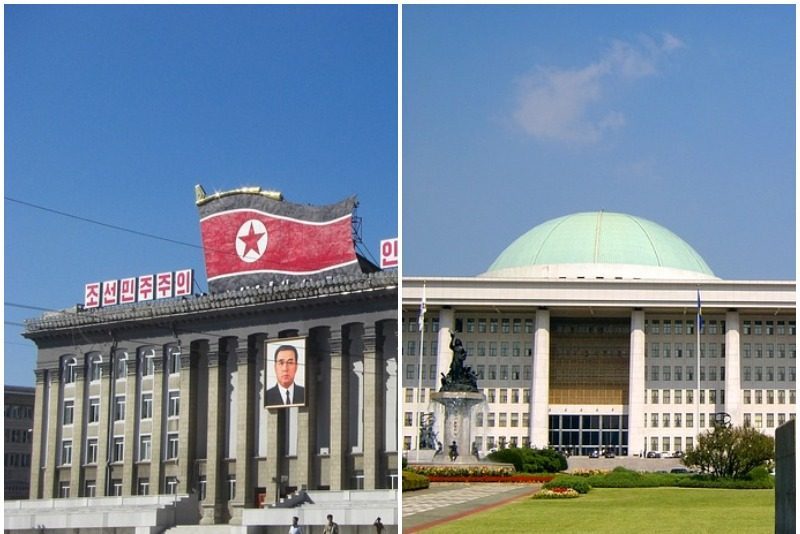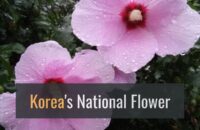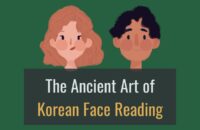Want to know the differences between North and South Korean languages?
Koreans used to speak a common tongue, but decades of separation have led to some interesting variations.
Find out how and why the Korean language is changing.

Quick Summary
- South and North Korean languages are becoming increasingly different, but they’re considered dialects and can be understood by speakers from both countries.
- South Korea adopted Japanese and English Loanwords, while the North creates Korean versions and uses Russian Loanwords when necessary.
Introduction
An interesting thing happened between North and South Korea during the 2018 Winter Olympics in Pyeongchang.
After being divided for 70 years by a war that’s still ongoing, their respective Women’s Ice Hockey teams were combined less than a month before the games.
Since South Koreans use English hockey terms and North Koreans developed Korean equivalents, communication was difficult at first.
One major difference is that South Koreans use the word “Pass”, while North Koreans use “yeol lak” (연락) or “contact” instead.
The head coach of the joint team actually had to create an English to South Korean to North Korean dictionary for hockey terms, so the two groups could communicate.
Fortunately, they managed to get along and do better than expected.
Origin of South and North Korean Languages
Before they became two countries, a Korean Language Society was formed to define the National Orthography(spelling system) in 1933.
This was called Hangeul Matchumbeop Tong-iran (한글 맞춤법 통일안), and was used until 1945.
After the establishment of the Republic of Korea (South Korea) and the Democratic People’s Republic of Korea (North Korea) in 1948, their policies regarding language started to diverge.
From the 1960s until 2003, the leadership of North Korea created their own language system based on the soviet model.
South Korea continued to follow the 1933 rules and any subsequent amendments.
More about Korean Language
After over 70 years of separation, it’s estimated that about a third of everyday words used in North and South Korea are different.
This is a similar rate of divergence to that of U.S. and British English, which have been separated by an ocean for nearly 250 years.
Part of this has to do with a centralized effort by North Korea to regulate the language and the fact that people are prohibited from viewing South Korean media; whereas American T.V. is popular in the U.K. and vice versa.
Some of these differences exist due to factors such as adoption of Japanese and English Loanwords in the South and Russian Loanwords in the North.
Since the languages are becoming increasingly different, a joint association of linguists from both countries was formed to compile a South to North Korean dictionary in the event reunification occurs.
This project is called Gyeoremal-keunsajeon (겨레말 큰사전).
Although it’s roughly 75% complete, the effort was suspended due to increased tensions from nuclear testing and the closing of the Kaesong Industrial Complex in the North.
Although we don’t get many requests for North Korean translation, it’s fun to learn about their unique words and grammar.
Here are some interesting differences between the two versions of Korean.
Background Info
- In South Korea, they refer to their language as Hangul whereas in North Korea, it’s known as Joseon-gul.
North Koreans use the word “Joseon” as a not-so-subtle way to claim authority over both the north and south, since it was the historical name of the first kingdom of Korea, and the name of the last dynasty that controlled the entire peninsula. - There have been different dialects in Korea for thousands of years.
Currently in South Korea, there are the Seoul and Gyeonggi-do dialect, Gangwon-do in the east, Chungcheong-do in the central west, Gyeongsang-do in the southeast, Jeolla-do in the southwest, and even Jeju-do on the southern island. - Pyeongyang in North Korea was the original capital of Korea according to legend of Dangun, the Korean foundation myth.
It was also the capital of numerous dynasties spanning centuries, including Gojoseon (2,333 BC??? to 108 BC) and Goguryeo (37 BC to 668 AD) during the three kingdoms period.
The dialect of Korean in the North was initially different from what was spoken in the South when the country split. - South Korea adopted Japanese and English Loanwords, while the North creates Korean versions and uses Russian Loanwords when necessary.
This is to keep the language purely Korean and to follow the dialect of Pyong’an. - The tendencies of North Korea often leave westerners baffled.
Many of these idiosyncrasies can be explained by its history and culture. - The founders of North Korea were considered freedom fighters against Japanese occupation.
They consider themselves the “true Korea”, while they view South Korea as a puppet of the U.S. and Japan. - North Koreans strongly reject anything related to capitalism, including goods, which they think are inferior, and even words.
Therefore, they reject Japanese and American influence and created Koreanized versions of words. - The majority of South Koreans aren’t worried about the North invading.
They are more concerned with their hectic daily lives and the effect on the KOSPI and KOSDAQ stock markets when North Korea does something provocative. - North Korea’s weapons, especially their artillery aimed at Seoul, are mostly from the Korean War period, so they aren’t guaranteed to work.
Militarily, their main chance is to bombard Seoul with these weapons and send their million troops who are malnourished and poorly equipped across the border to overwhelm South Korea numerically. - North Korea’s playbook is similar to the “carrot and the stick” method.
They’ll threaten military action then give the South hope of reconciliation only to break it off when things are looking up.
They have done this numerous times in the past 70 years and it’s largely to gain aid and maintain power over the populace.
It’s also highly unlikely that they’ll denuclearize, given how Ukraine and Libya have fared after doing so. - As with most things, the truth is far more nuanced and complicated than what’s condensed and passed off as news.
North Korea is a media black hole that makes reliable news hard to come by.
Also, there’s a wide gulf in cultures between the west and east, so understanding events in context is difficult.
Therefore, a lot of information on North Korea is inaccurate and sensationalized to increase views (no, North Korea didn’t claim to have discovered unicorns).
It’s important to check sources when reading about the country.
There are some differences since the concepts of words have change due to socio-political factors in North Korea.
Divergent meanings due to socio-political factors
The Korean Peninsula is called Hanbando(한반도) in the South, while it’s referred to as Joseonbando (조선반도) in the North.
As mentioned above, North Koreans use the name “Joseon” to claim legitimacy over both the North and South.
Hanguk jeonjaeng (한국 전쟁) is what South Koreans call the Korean War, but North Koreans call it Choguk’aepangjŏnjaeng(조국해방전쟁) or “Liberation of the Fatherland War”.
Again, another reference to the fact that Northerners think that the South is occupied by capitalist forces.
South Koreans call elementary school, chodeunghakkyo(초등학교), while North Koreans call it sohakkyo(소학교).
Sohakkyo was actually used before the Japanese occupation(1910-1945), when it was changed to 보통학교, which were basically colonial slave training facilities.
Then in 1938, it switched to 심상소학교, and in 1941, 국민학교.
After the Korean war, North Korea changed it to 인민학교, or “people’s school”.
South Korea wanted to use the same name too, but 국민학교, or “national school”, sounded better to the anti-communist government.
The R.O.K. kept using 국민학교 until 1995, when they changed it to 초등학교.
North Korea changed the name to 소학교 (small school) in 2002, following the trend of other east Asian countries.
In South Korea, the word for friend is chingu (친구), but in the North it’s dongmu, (동무) or “comrade”, which is a soviet concept.
Eobeoi (어버이) for instance means “parents” in South Korea, but has been altered to mean the “symbolic title of Kim Il Sung” in the North, which implies that he’s the father to everyone in Korea.
Agassi means “girl” or “miss” in the South, but it means “slave of feudalism” to Northerners.
Another interesting example is “gungjeon” or “palace” in the South, which means “large palace-like building for social activities” in the North.
This is where mass rallies are held by North Koreans.

Differences in Hangul Usage in South and North Korea
Character Order
In South Korea, vowels are in this order:
ㅏ ㅐ ㅑ ㅒ ㅓ ㅔ ㅕ ㅖ ㅗ ㅘ ㅙ ㅚ ㅛ ㅜ ㅝ ㅞ ㅟ ㅠ ㅡ ㅢ ㅣ
with consonants in this order:
ㄱ ㄲ ㄴ ㄷ ㄸ ㄹ ㅁ ㅂ ㅃ ㅅ ㅆ ㅇ ㅈ ㅉ ㅊ ㅋ ㅌ ㅍ ㅎ
In North Korea, vowels are ordered like this:
ㅏ ㅑ ㅓ ㅕ ㅗ ㅛ ㅜ ㅠ ㅡ ㅣ ㅐ ㅒ ㅔ ㅖ ㅚ ㅟ ㅢ ㅘ ㅝ ㅙ ㅞ
with consonants in this sequence:
ㄱ ㄴ ㄷ ㄹ ㅁ ㅂ ㅅ ㅇ ㅈ ㅊ ㅋ ㅌ ㅍ ㅎ ㄲ ㄸ ㅃ ㅆ ㅉ ㅇ
Character Names
Some characters and digraphs have different names in the South and North.
| Letter | South Korean Name | North Korean Name |
| ㄱ | 기역 | 기윽 |
| ㄷ | 디귿 | 디읃 |
| ㅅ | 시옷 | 시읏 |
| ㄲ | 쌍기역 | 된기윽 |
| ㄸ | 쌍디귿 | 된디읃 |
| ㅃ | 쌍비읍 | 된비읍 |
| ㅆ | 쌍시옷 | 된시읏 |
| ㅉ | 쌍지읒 | 된지읒 |
Character Usage
Both countries use the same characters, however, in North Korea, the letter ㅌ that represents the letter T is written as ㄷ with a separate horizontal stroke on top.
Character organization is different as well.
Additionally, the digraphs and trigraphs in South Korean vowels,ㅔ, ㅖ, ㅘ, ㅙ, ㅚ, ㅝ, ㅞ, ㅟ, ㅢ and the consonant digraphs ㄲ, ㄸ, ㅃ, ㅆ, ㅉ aren’t used separately and require a ㅇ for vowels and a vowel for consonants respectively.
In North Korea, they’re used as separate letters.
Some letters and digraphs have different names in the South and North.
Pronunciation
As we touched on earlier, the North Korean language is based on the Pyong’an dialect, while South Korean is based on the Seoul dialect.
This leads to some notable differences.
It’s difficult to make generalizations regarding how both languages sound, since there’s a large amount of variation within each dialect.
Some generalizations are that North Korean sounds more old-fashioned and militant to South Koreans.
This is exacerbated by state news announcers in North Korea who sound like they’re declaring war, even when they’re reading the weather forecast.
Not surprisingly, North Koreans will often lose this accent when living in South Korea.
On the other hand, South Korean sounds smoother and weaker to North Koreans.
Consonants
In the Seoul dialect, ㅈ, ㅊ and ㅉ are usually pronounced with alveolo-palatal affricates [tɕ], [tɕʰ], [tɕ͈].
This means they will sound more like a “ch” sound in English.
In the Pyongyang dialect, they’re predominantly pronounced with alveolar affricates [ts], [tsʰ], [ts͈].
This means that they sound more like an “s” sound.
Also, 지 and 시 can be pronounced without palatalisation as [tsi] in the Pyongyang dialect, which sound more like a “sh” sound.
In Sino-Korean words, sometimes ㄴ and ㄹ letters that come at the beginning of a word aren’t pronounced or written in the South, but all beginning ㄴ and ㄹ are written in the North.
For example, South Koreans typically don’t pronounce and write the initial ㄹ(r/l) and some of the initial ㄴ (n) while they’re written and pronounced in North Korea.
For example, the surname “Lee” is written as 이 and pronounced as “ee” with a short ”i” sound.
In North Korea however, it’s written as 리 and pronounced as”Ri.”
Also, the South Korean word 여자, meaning woman, is written as 녀자 in North Korea.
But since this pronunciation was mandated in the North during the 1960s, it’s common for older speakers to be unable to pronounce initial ㄴ and ㄹ properly, so they pronounce them the same way they do in the South.
Vocabulary Differences Between South and North Korea
| English | South Korean | North Korean |
| airport | 공항 gonghang | 항공역 hanggongyeok |
| become | 되어 (돼) doe-eo (dwae) | 되여 doe-yeo |
| bloom | 피어 (펴) pieo (pyeo) | 피여piyeo |
| boat | 배 bae | 젓기배 jeotgibae |
| border (be close to) | 국경 (인접하다) gookgyung (injeophada) | (린)접(하다) (rin)jeop(hada) |
| central area | 중심부 joongsimbu | 중앙부 joongangbu |
| cold water | 냉수 naengsu | 랭수 raengsu |
| corn | 옥수수 oksusu | 강냉이 gangnaeng-i |
| count | 세어 se-eo | 세여 se-yeo |
| cow cart | 수레 su-re | 달구지 dalguji |
| crosswalk | 횡단보도 hwengdanbodo | 건늠길 gunnumgil |
| doughnut | 도넛 do-neot | 가락지빵 garakjibbang |
| dream | 꿈 ggoom | 잠나라 jamnara |
| elementary school | 초등학교 chodeunghakkyo | 소학교 sohakkyo |
| entrance | 입구 ibgu | 나들문 nadulmun |
| fall | 낙하 nakha | 락하 rakha |
| friend | 친구 chingu | 동무 dongmu |
| goalkeeper | 골키퍼 golkipeo | 문지기 munjigi (literally ‘gatekeeper’) |
| goose | 거위 geowi | 게사니 gesani |
| hammer | 망치 mangchi | 마치 machi |
| handbag | 핸드백 haen-deu-baeg | 손 가방 son-ga-bang |
| homeland | 본국 bon-gook | 조국 jo-gook |
| ice cream | 아이스크림 aisukuream | 에스키모/얼음과자 esukimo/eoreumgwaja |
| jump | 뛰어 ttui-eo | 뛰여 ttui-yeo |
| Korean Peninsula | 한반도 Hanbando | 조선반도 Choseonbando |
| Korean War | 한국 전쟁 Hanguk jeonjaeng | 조국해방전쟁 Choguk haebangjeonjaeng |
| lettuce | 상추 sangchu | 부루 buru |
| mask | 마스크 masuku | 얼굴가리개 eolgulgarigae |
| milk | 우유 ooyu | 소젖 sojeot |
| multi-national | 다국적 da-gook-jeok | 다민족 da-min-jok |
| near | 가까워 gakkawo | 가까와 gakkawa |
| past | 과거 gwageo | 어제날 eojaenal |
| Poland | 폴란드 Pollandeu | 뽈스까 Ppolsukka |
| practice | 연습 yeonseup | 련습 ryeonseup |
| rainbow | 무지개 mujigae | 색동다리 saekdongdari |
| restroom (lavatory) | 화장실 hwajangsil | 위생실 wisaengsil |
| sausage | 소시지 sosiji | 칼파스, 고기순대 kalpasu, gogisundae |
| scarf | 목도리 mokdori | 목수건 moksugeon |
| stairs | 계단 gyedan | 디대 didae |
| stocking | 스타킹 seutaking | 스토킹 sutoking |
| store | 가게 gagae | 가가 gaga |
| take out | 내어 nae-eo | 내여 nae-yeo |
| territory | 영토 yeongto | 령토 ryeongto |
| thankful | 고마워 gomawo | 고마와 gomawa |
| tractor | 트랙터 teuraekteo | 뜨락또르 tturakttoru |
| vegetable | 야채 yachae | 남새 namsae |
| white | 희어 hieo | 희여 hiyeo |
| woman | 여자 yeoja | 녀자 nyeoja |

FAQ
How different is North and South Korean language?
While the two languages are becoming increasingly different, they’re still technically the same. They’re considered dialects and can be understood by speakers from both countries.
What did the North Korean language originate from?
Both North and South Korean originate from the same language, Korean.
When did North and South Korean language split?
They’re considered the same language, but they became dialects when the two countries split in 1948.
What language do North Koreans and South Koreans speak to each other?
In the rare cases when citizens of both countries interact, they speak the same language, Korean. But, they use different dialects.




